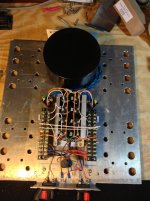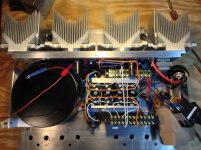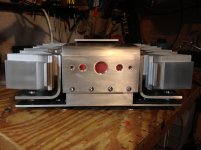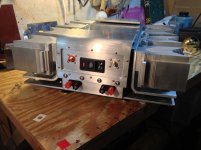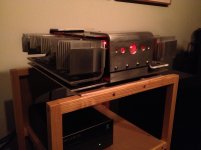Hi jdg123,
P1 and P2 act as voltage dividers across their respective zeners so as ZM stated,
you should be able to get the full range adjustment.
If you're stuck at around 3V (or 5.4-3V, depending on which pins you're measuring)
then it makes sense your mosfets are 'off'.
Hopefully you will get this resolved soon.
Dennis
P1 and P2 act as voltage dividers across their respective zeners so as ZM stated,
you should be able to get the full range adjustment.
If you're stuck at around 3V (or 5.4-3V, depending on which pins you're measuring)
then it makes sense your mosfets are 'off'.
Hopefully you will get this resolved soon.
Dennis
Yes I can get it from zero all the way up to 5.4 now that I've checked All the way to the "clicking" end of adjustment.
What next?
What next?
Is it possible you simply did not adjust the pots enough to turn on the mosfets
originally? It seems when you measured them they were at around 3V?
originally? It seems when you measured them they were at around 3V?
agree
solder resistors back , put one mVmeter on output (ref. to gnd) and second across one source resistor ..... and try to bias it
I believe that's covered in build guide routine
solder resistors back , put one mVmeter on output (ref. to gnd) and second across one source resistor ..... and try to bias it
I believe that's covered in build guide routine
Yes it seems that room I just didn't go far enough yet the guide says that at the factory setting of halfway I might be getting too much by us already, that's what made me think something was seriously wrong. I'll try to get in the morning and report back🙄
Ah...I think that remark about the bias was based on a higher zener voltage.
Let's say your pot is set at mid point then a 9.1V zener will give a Vgs voltage
around 4.5V which likely will give you a high current value for an IRFP240.
On the other hand, with a 5.6V zener, you get 2.8V and your mosfet likely isn't
even on.
Let's say your pot is set at mid point then a 9.1V zener will give a Vgs voltage
around 4.5V which likely will give you a high current value for an IRFP240.
On the other hand, with a 5.6V zener, you get 2.8V and your mosfet likely isn't
even on.
You guys are so right! I had to nearly top out the pots to get the amp to bias! That said, it's nice and stable now.
Big thanks to you all!!
I'll show pics when I've got both channels tuned and the skin on (yes I'll include some "nudes" 🙂
Cheers!
Big thanks to you all!!
I'll show pics when I've got both channels tuned and the skin on (yes I'll include some "nudes" 🙂
Cheers!
Have you still got 10K for R7 / R8?
With the lower voltage zenner the suggestion is to reduce these (I use 3K3.)
but 5K or 7K have been suggested.
Maths on about page 66.
With the lower voltage zenner the suggestion is to reduce these (I use 3K3.)
but 5K or 7K have been suggested.
Maths on about page 66.
Hey thanks for the excellent pointer. Like I said the thread lost me �� Maybe now it'll make more sense to me.
Cheers!
Cheers!
rebias after that
even better - back down with bias , prior to changing resistors , then rebias
even better - back down with bias , prior to changing resistors , then rebias
jdg123,
Happy for you! Give us your sonic impressions when you can. My enclosure for my F6 build just arrived.
Best,
Anand.
Happy for you! Give us your sonic impressions when you can. My enclosure for my F6 build just arrived.
Best,
Anand.
Last night I got both channels to 1.25 amps, 110 degrees F after one hour, zero offset. That just may be "good enough".
Going to finish buttoning up, check it out one more time for an hour or so then give it a listen. I promise pics and impressions 🙂
Going to finish buttoning up, check it out one more time for an hour or so then give it a listen. I promise pics and impressions 🙂
F6 impressions
OK, one hour of listening, first impressions of my new F6:
First off, it startled me, heck, it even scared me! You know that sinking feeling when you hear a sound from your stereo that might be something popping/blowing up or some such like a big "whump" you didn't expect? Absolutely nothing was wrong. I was just not used to hearing things in the recording that were there all along. OMG is this thing broad and revealing! It's big! Yet it retains a very good sense of tone.
Make no mistake, Nelson Pass is at the top of his game 🙂)
And here comes all the qualifiers...
I usually listen to an Aleph J with an Aikido tube pre (in my workshop). This combination can, on some recordings bring me almost to tears. It is quite beautiful and I'm a sap 🙂 Swapping in the F6 was so new to me and even after a half an hours a bit cold (only by comparison) that I knew that landing place was not the best for the F6. I moved it out to a bigger room and bigger speakers: KEF 104/2. There it proved its breeding. In a bigger room the big nature of this amp comes better to the fore. Even the tone seemed better. I was pinned to my chair. I was grinning. And for note: what normally runs those KEF's is a F5v2. This is why I say NP is really on his game; his most popular First Watt has been outshone: the F6 is better than the F5.
Of course you can hear the family resemblance, and some will disagree sharply but not me. I'm 57 so go my tastes toward the poignant. I'm more emotional and require this from the music. I think that's what the F6 has over the F5. and it's BIG! I kept looking at it thinking how does all that sound pour out of that little package (my version is only 16 x 16 inches).
OK, now on to the tech and images...
I made it just stock but 400VA on the TX using Muse caps on the boards. The wire is silver over copper but I don't think it makes a big difference. All the contacts are quite pedestrian. I really liked using the long barrier strip for construction; build a right channel, build a left channel. The PSU gets it's own plate. I just extended the leads on the board's LEDs to light the front using coms copper mesh to disperse the light. I can't say how many holes and drill and tap operations there are...a lot! It's just what you have to do when your working with scrap. Yep, the whole thing is from the metal recycler's yard.
Thank you all so much and I bow low to the generosity of Nelson Pass. Wow, what a cool way to be at peace in my own little shop and then even more in my listening room.
Cheers!
pictures to follow....something about a security token...
OK, one hour of listening, first impressions of my new F6:
First off, it startled me, heck, it even scared me! You know that sinking feeling when you hear a sound from your stereo that might be something popping/blowing up or some such like a big "whump" you didn't expect? Absolutely nothing was wrong. I was just not used to hearing things in the recording that were there all along. OMG is this thing broad and revealing! It's big! Yet it retains a very good sense of tone.
Make no mistake, Nelson Pass is at the top of his game 🙂)
And here comes all the qualifiers...
I usually listen to an Aleph J with an Aikido tube pre (in my workshop). This combination can, on some recordings bring me almost to tears. It is quite beautiful and I'm a sap 🙂 Swapping in the F6 was so new to me and even after a half an hours a bit cold (only by comparison) that I knew that landing place was not the best for the F6. I moved it out to a bigger room and bigger speakers: KEF 104/2. There it proved its breeding. In a bigger room the big nature of this amp comes better to the fore. Even the tone seemed better. I was pinned to my chair. I was grinning. And for note: what normally runs those KEF's is a F5v2. This is why I say NP is really on his game; his most popular First Watt has been outshone: the F6 is better than the F5.
Of course you can hear the family resemblance, and some will disagree sharply but not me. I'm 57 so go my tastes toward the poignant. I'm more emotional and require this from the music. I think that's what the F6 has over the F5. and it's BIG! I kept looking at it thinking how does all that sound pour out of that little package (my version is only 16 x 16 inches).
OK, now on to the tech and images...
I made it just stock but 400VA on the TX using Muse caps on the boards. The wire is silver over copper but I don't think it makes a big difference. All the contacts are quite pedestrian. I really liked using the long barrier strip for construction; build a right channel, build a left channel. The PSU gets it's own plate. I just extended the leads on the board's LEDs to light the front using coms copper mesh to disperse the light. I can't say how many holes and drill and tap operations there are...a lot! It's just what you have to do when your working with scrap. Yep, the whole thing is from the metal recycler's yard.
Thank you all so much and I bow low to the generosity of Nelson Pass. Wow, what a cool way to be at peace in my own little shop and then even more in my listening room.
Cheers!
pictures to follow....something about a security token...
one of the coolest and Fugly!-est drek I ever seen ...
it would be pity that you chose to made it in pre-fabricated case , having such mindset

it would be pity that you chose to made it in pre-fabricated case , having such mindset

- Home
- Amplifiers
- Pass Labs
- F6 Illustrated Build Guide
